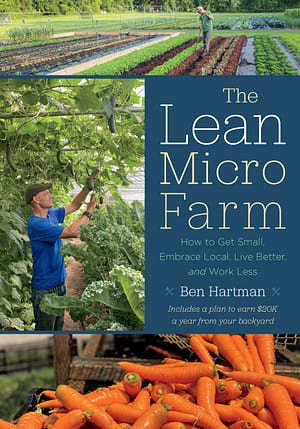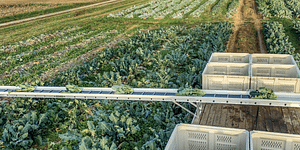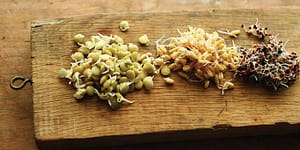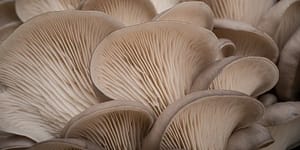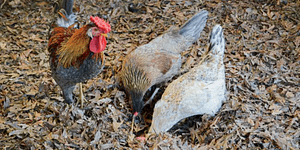Simplify Farm Fieldwork: Stop Working So Hard

Looking to simplify fieldwork on your farm? The key is to act like a tree: stop working so hard and let nature do some of the work for you.
The following is an excerpt from The Lean Micro Farm by Ben Hartman. It has been adapted for the web.
Unless otherwise noted, all photographs and illustrations copyright © 2023 by Clay Bottom Farm.
Farm Like a Tree: Simplify Fieldwork
A single tree, though it never moves, can be astoundingly productive. Mature pecan and chestnut trees produce about 100 pounds of nuts in a single season; a healthy apple tree will grow 15 bushels of apples in a year; a sugar maple tree, in a good season, will deliver 20 gallons of sap.
How do they do it? In the past few years, we have planted hundreds of trees on our farm, reforesting areas that we are not using to grow crops. I’ve observed and thought a lot about trees recently. Here are four observations that I think help explain their productivity.
1. Trees Work Ahead
Trees can be so productive because they spend years preparing. The fruit and nut trees that we planted, for example, use their first few seasons to create a strong scaffold of branches before producing heavy loads of fruit. They prepare ahead for high productivity.
Similarly, we’ve learned that it is better to set up carefully before jumping into production.
Before our season begins, we take stock, making sure we have ordered enough (but not too many) row covers, clamshell contain- ers, tomato boxes, and other supplies that we will need in the months ahead.
As I write this, in the midwinter, we are preparing to transplant tomatoes in a greenhouse in March. We are disinfecting trays, landscape fabric, and the germination chamber and taking inventory of labels, stakes, and other supplies necessary for the job.
We work ahead in the field, too. If we want to use a bed in the spring, we’ll prepare it in the fall, adding compost months ahead of when the bed will be planted. (The compost itself was made at least a year ahead.)
We have more time in the fall, so we are less rushed and more likely to do a better job. It is best not to farm in the moment, when you are prone to always playing catch-up. Think ahead and prepare.
2. Trees Leave Plant Matter In Place
Trees understand the value of a dead leaf. A full-grown maple tree has about 500 square feet of leaves weighing about 500 pounds.
The total chloroplast surface area of a single tree equals about 140 square miles—an impressive solar array. By fall, these leaves are full of carbon, nitrogen, phosphorus, potassium, calcium, and other nutrients.7
It is a great tragedy that so many people feel compelled to throw leaves in the trash—or, worse yet, to burn them.
The trees we planted don’t move their leaves. They just let them drop and decompose in-situ, in their origi- nal place, to feed themselves and organisms in the soil life.
Many gardeners move dead plants out of the garden at the end of the season to clean up the garden and supposedly prevent disease.
For many years, because of what we were taught, we cleaned up in the fall like this, pulling plants, roots and all, and moving them to a compost heap.
Now we take a different approach. As much as practical, we let old plants decompose in place, where minerals from their leaves, stalks, and roots feed the soil, like a tree.
3. Trees Practice Quiescence
Conventional wisdom says that trees in winter are dormant to conserve energy. Aboveground, this is mostly true, but new research shows that belowground is a different story.
Michael Snyder, writing for Northern Woodlands magazine, explains, “Tree roots seem to maintain a readiness to grow independent of the abo- veground parts of the tree. That is, roots remain mostly inactive but can and do function and grow during winter months whenever soil temperatures are favorable, even if the air aboveground is brutally cold.”
This is called winter quiescence, where roots are resting but ready.
It is a survival tactic important for the health of the tree. “It is this trait that allows evergreens to absorb soil water and avoid winter desiccation in their needles,” writes Snyder. Quiescence “allows all species, including decidu- ous hardwoods, the opportunity to expand their root systems in search of water and nutrients in advance of spring bud break.”8
On a farm, winter is a great time to both rest and expand.
Days are shorter, and there is less work to do. It’s important to sleep more and work less.
But the cold season is also the best time to explore new growing techniques, redesign tools, and visit other farms to learn new skills in preparation for the spring. Trees are a case study proving it is possible to rest and prepare at the same time.
Notes
- Joseph R. Heckman, Daniel Kluchinski, and Donn A. Derr, “Plant Nutri- ents in Municipal Leaves,” Rutgers Cooperative Research and Extension, Fact Sheet FS824, 2004, accessed November 16, 2022, https://sustainable-farming.rutgers.edu/wp-content/uploads/2014/09 /Municipal_Leaves_Plant_Nutrients_Available_FS824_1998.pdf.
- Micheal Snyder, “What Do Tree Roots Do in Winter?,” Northern Woodlands, December 1, 2007, accessed November 16, 2022, https:// northernwoodlands.org/articles/article/what_do_tree_roots_do _in_winter.
Recommended Reads
Recent Articles
Oxeye daisies are one of the most important plants for pollinators including beetles, ants, and moths that use oxeye daisies as a source of pollen and nectar. Instead of thinking about removing a plant like oxeye daisy, consider how you can improve the fertility and diversity of habitat resources in your home landscape, garden, or…
Read MoreSo you want to start reaping your harvest, but you’re not sure where to start? Learn how to break down the options of harvesting tools!
Read MoreWhat’s so great about oyster mushrooms? First, you can add them to the list of foods that can be grown indoors! They are tasty, easy to grow, multiply fast, and they love a variety of substrates, making oyster mushrooms the premium choice. The following is an excerpt from Fresh Food from Small Spaces by R. J.…
Read MoreEver heard the phrase, “always follow your nose?” As it turns out, this is a good rule of thumb when it comes to chicken manure. Composting chicken manure in deep litter helps build better chicken health, reduce labor, and retain most of the nutrients for your garden. The following is an excerpt from The Small-Scale Poultry…
Read More

